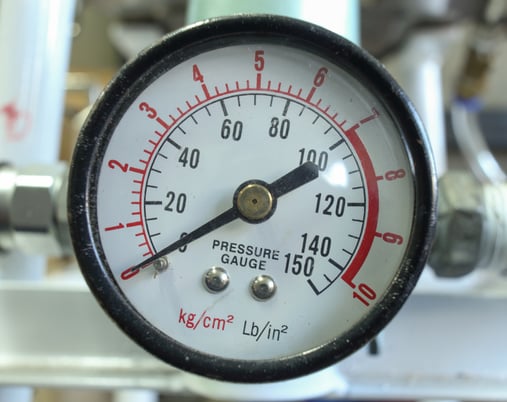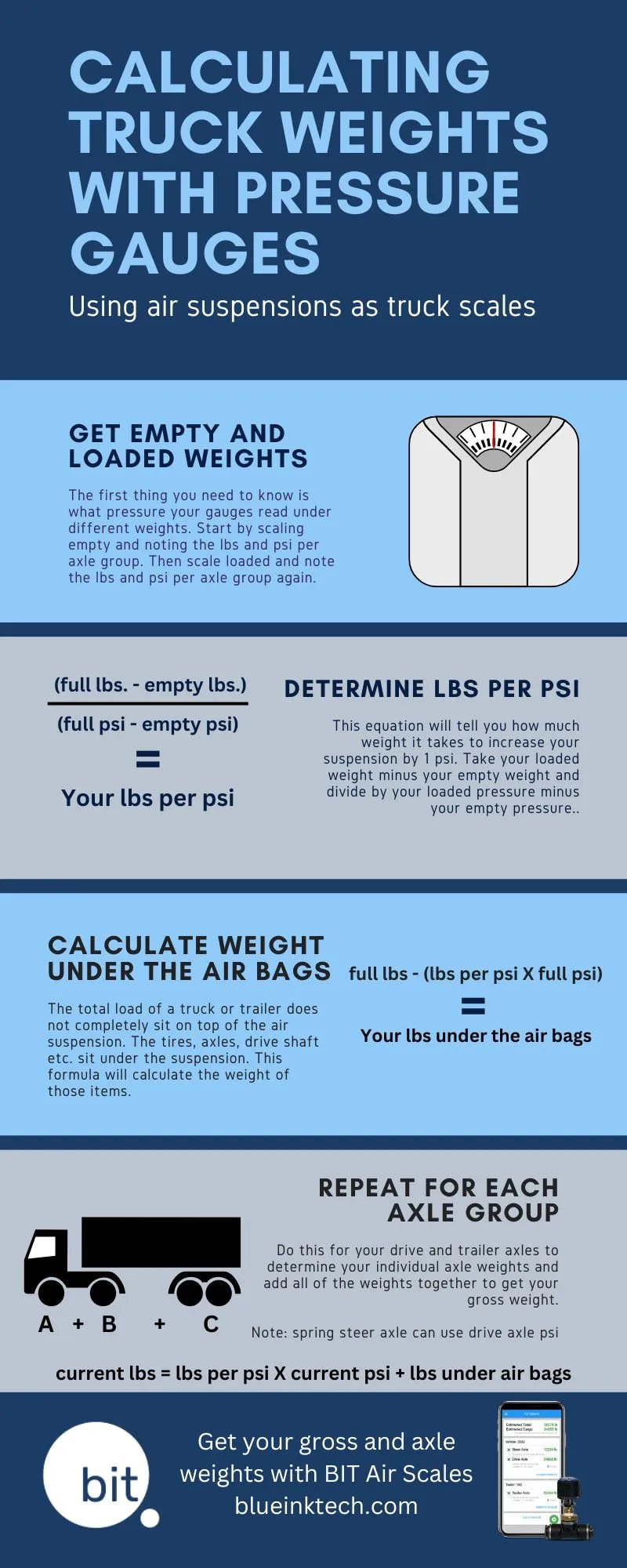Today's trucks and trailers are almost all manufactured with air suspension to make the ride as smooth as possible, reduce strain on the truck's drive train, and improve fuel mileage. It's also paved the way for air suspension truck scales and pressure gauges to measure load weight. Suspension truck scales are great because they don't interfere with the trailer raising and lowering to keep a stable ride height. They're also easily installed and replaced, which minimizes the amount of downtime needed to maintain them.
Another great feature of air suspension truck weight scales is that they use simple math to calculate load weight. If drivers can read the pressure in their air bags, they can know how much weight they're hauling. This can help combat scale fraud and help companies maximize their earning on loads.
How can I find my truck weight with my air suspension?
Most trucks and trailers come with a needle pressure gauge mounted in the cab and around the trailer frame so the driver can read the pressure on the suspension. If your truck or trailer does not have a pressure gauge, you can easily install one to get the pressure in the air suspension. They usually take about 10 minutes to install and require basic tools to get installed.
To read a needle gauge you will need to be able to associate a weight with a specific pressure. Many drivers just want to know if they are overloaded or legal. These drivers will max out the weight allowed for the truck and trailer using a little trial and error and note what PSI the gauge shows with a maxed-out load. Every future load that reads below that PSI should be legal. Every load over that PSI is possibly overloaded.
What is the accuracy of reading weights from an air suspension?
The range of accuracy when using pressure to determine weight can be anywhere from 2,000 lbs. to 80 lbs. depending on what type of gauge you are using.
For truck and trailer readings, 1 psi is equal to about 480 lbs. on average. Using a gauge that has a high precision can get you very accurate readings.
Some needle gauges read out every 5 psi or so. The margin of error can be large for these types of gauges. The difference between estimating what 41 PSI is and what 43.2 PSI is a 1,000 lb difference in terms of weight on the truck or trailer.

If you are looking for more accurate readings, you will want a pressure gauge on your air suspension that reads into the hundredths position (ex: 62.45 psi). A pressure weight gauge that can read out to this resolution can be as accurate with in 80 lbs. on the truck or trailer.
Depending on what your application is you may be able to get by with a needle gauge to just give a rough idea of whether you are overloaded or legal. If you need to have a higher level of accuracy you will want to consider an onboard truck scale solution that has a high resolution.
What are the downsides to reading truck weights with air suspensions?
Using air suspension gauges to determine truck weight is a great way to quickly understand how much weight a truck is hauling, but these truck scaling systems are not meant to be legal for trade or certified by a third party.
If the type of commodity you are hauling is based on how much you can carry, or you are paid by weight, you will have to use a scale that has been certified to get your exact truck weight. However, needle gauges can be incredibly useful to let drivers know if they have room for a little bit more or if they should tarp up and go.
Additionally, if you have a fleet of drivers who drive multiple trucks and trailers, using needle-based gauges can be difficult. Many trucks and trailers are slightly different and training drivers on how the gauges read on every truck and trailer will be an uphill task.
Why should I use pressure gauges to get my truck weight?
The cost to scale loads is a huge expense on a trucking company and adds to a trucks total cost per mile. DOT enforcement is always looking for overloaded trucks that can damage roadways and raise infrastructure costs, which we all end up feeling in higher taxes.
With this in mind, many carriers make drivers pay to scale every load to avoid a run-in with the DOT at a weigh station. Overweight violations can come with large fines and can impact a carriers CSA score which can lead to more serious consequences.
A trucking company can easily pay over $1,300 per truck per year just on scale tickets. Most of the time this is the cost of peace-of-mind because not every load is overweight.
If trucks are overloaded, drivers either need to go back to the shipper to get something adjusted or removed or risk getting a fine or placed out-of-service by the DOT.
Using air suspension gauges can help drivers know if they're overloaded on an axle or gross and fix the problem before they get on the road and risk paying the price of not knowing what the truck weighs.
Pressure gauges are also great at helping balancing your load to make a smoother ride. Getting a balanced load will help with proper load securement while and makes sure you are not over weight on an axle group before tarping or tying down cargo.


